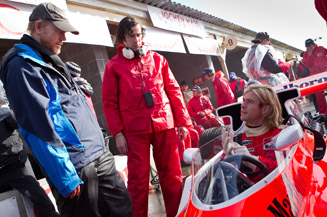Movie Review: Rush
By Matthew Huntley
October 3, 2013
BoxOfficeProphets.com

One subject I never thought would take on meaning is Formula One auto racing, nor one of its real-life rivals, but Howard makes that happen with Rush, which starts out like any other sports saga but gradually develops and intensifies as it speeds along. The rivalry is between England’s James Hunt (Chris Hemsworth) and Austria’s Niki Lauda (Daniel Brühl), and for those who might be unaware, just as I was, these were two of the global sport’s most famous competitors.
At first, Peter Morgan’s screenplay, which chronicles Hunt and Lauda’s racing careers between 1970 and 1976, sums these two men up in terms of broad strokes—with James being the wild, crass and pompous womanizer with long blonde hair who drinks and abuses drugs; and Niki as the uptight, no-nonsense workaholic with the face of a rat whom none of the other racers like, though deep down they secretly admire his austerity. Once Morgan’s script establishes Hunt, Lauda and the context of their world, it frees itself up to develop these men on a more personal level and shifts from telling an ordinary sports story to a more affecting human drama.
Hunt and Lauda first meeting during a Formula Three race (the “formula” refers to a set of standards each car must meet, with one being the highest), where James cuts Niki off, causing him to swerve and lose the match. From then on, the two are enemies, at least professionally. However, as Niki later points out, “A wise man can learn more from his enemies than a fool from his friends.” Indeed this is the case for Hunt and Lauda, as each makes the other man his primary motivation to keep on racing and vying for the title of world champion, no matter the driving conditions. The movie focuses on the fact that winning is part of their essential natures; for Hunt and Lauda, racing gives their lives purpose, and we sense their anxiety and fear when they think about it going away. They race not for fame, fortune or women - although each of these is a nice perk - but because it’s their livelihood. Without it, they would die.
Although we don’t get to know James and Niki too far beyond the world of racing, we do meet the women who either choose to follow or leave them in their quest to be the best. We learn from the opening scene that James isn’t the type of man to settle down and be happy with just one woman, which is why we suspect his marriage to model Suzy Miller (Olivia Wilde) will be short-lived. But their relationship isn’t tossed in just create drama; it serves to underline that James is man who puts racing above all else, and what’s refreshing about Rush is that it doesn’t necessarily view his love and obsession with the sport as a bad thing. It’s simply who he is, and he’s not about to apologize for it. As the movie’s tagline reads, “Everyone’s driven by something.”
The same goes for Niki, who’s willing to estrange himself from his family, take out a personal loan from the bank and buy his way into the international racing circuit. Unlike James, though, Niki is less reckless and more mathematical in his approach; he views Formula One racing as just that - a sport that can be solved and won with a definite formula. His own rush comes from formulating ways to go faster and sustaining his title, all while firmly avoiding anything with a risk factor greater than 20%.
The woman in Niki’s life is Marlene (Alexandra Maria Lara), who’s impressed by the way he’s able to discipline himself and evaluate any and all decisions on a cost-benefit basis. Even when the two decide to marry, he tells her, “I suppose if I was going to do this with anyone, it might as well be you,” suggesting his decision stems from pragmatism instead of love. But he gradually comes to adore her and the movie’s heart comes from their budding relationship, which gives it a fair amount of poignancy.
We’re also struck, on a technical level, by Anthony Dod Mantle’s cinematography, which is exceptional in the way it places us, quite literally, in the driver’s seat and allows us to see the world from Hunt and Lauda’s perspectives. The racing scenes are vibrant and convincing, even when they’re mixed with digital effects. Oddly enough, though, one of the most important shots doesn’t take place in a car, but in a hospital room when Niki is putting on his helmet, and all the elements of photography - depth of field, focus and colors - play an important role. It’s moments like these that elevate Rush above the traditional sports movie label and into the realm of a film about people who play a sport.
Is Rush transcendental? No. Does its historical context and classic Hollywood structure make many scenes feel obligatory? Yes. But by the end, we come to see James Hunt and Niki Lauda as two real people who we care about. This is underlined by the newsreel footage at the end, which also makes us recognize just how spot-on the casting was when it came to finding actors who looked the part of each man. Hemsworth and Brühl are dead ringers for their real-life counterparts, and more importantly, they infuse them with personality and depth. They and the movie help us understand what was at stake for the racers, and this realization not only makes Rush solid entertainment, but it gives it meaning.